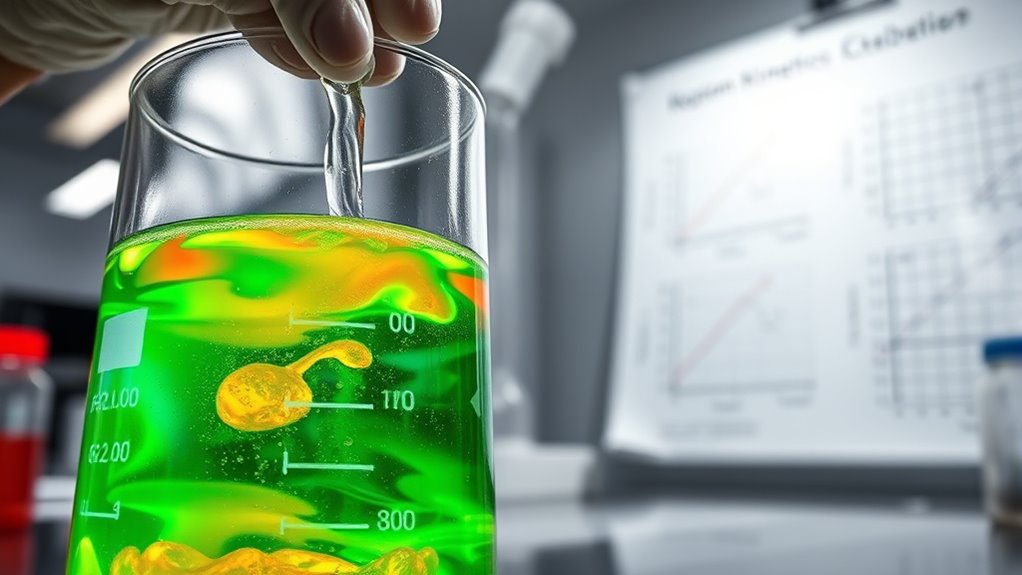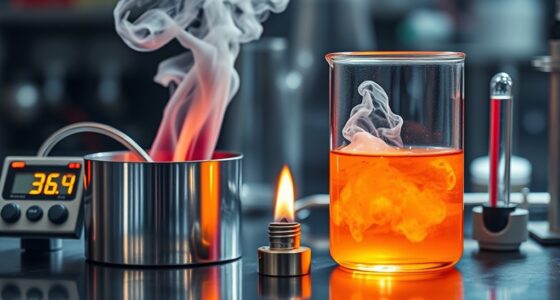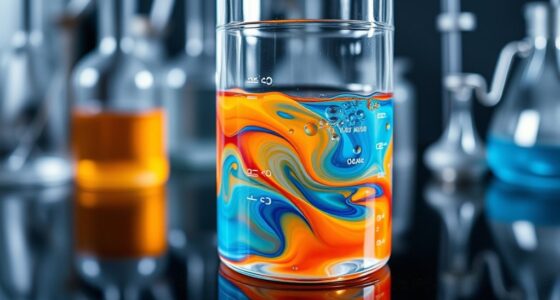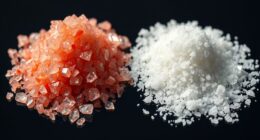Chemical kinetics explains how and why reactions happen at different speeds. It covers reaction rates, mechanisms, and how factors like concentration and temperature influence reaction speed. You’ll learn about rate laws, catalysts, and how to measure these changes through techniques such as spectrophotometry or pressure measurements. Understanding these core ideas helps you predict and control reactions in lab, industry, or the environment. Keep exploring, and you’ll discover even more about how reactions work behind the scenes.
Key Takeaways
- Chemical kinetics studies reaction rates, mechanisms, and how various factors influence the speed of chemical reactions.
- Reaction rate depends on concentration, temperature, catalysts, and activation energy.
- The rate law mathematically relates reaction rate to reactant concentrations and reaction order.
- Catalysts lower activation energy, increasing reaction speed without being consumed.
- Understanding kinetics helps optimize industrial processes, control reactions, and predict reaction behavior.
What Is Chemical Kinetics?

Have you ever wondered how quickly a chemical reaction happens? That’s where chemical kinetics comes in. It’s the study of reaction mechanisms—how reactants turn into products step by step. It’s essential to understand reaction pathways, which reveal the detailed pathway of atoms and molecules during the process. Catalyst effects also play a vital role; catalysts speed up reactions without being consumed, often by providing alternative pathways with lower activation energy. Understanding these factors helps you predict reaction rates and control them in real-world applications. By analyzing reaction mechanisms, chemists can determine which steps are rate-determining and how different conditions influence speed. For example, the role of temperature is crucial in affecting reaction rates, as higher temperatures typically increase the speed of reactions. Knowledge of modern toilet technology can also serve as a metaphor for understanding complex systems and their efficiencies. This foundational knowledge is essential for designing efficient reactions in industries like pharmaceuticals, energy, and manufacturing.
Understanding Reaction Rates

Understanding reaction rates helps you see how quickly a chemical reaction occurs. Factors like temperature, concentration, and catalysts influence this speed, and measuring the rate involves specific techniques. By applying rate law principles, you can predict and control reaction behavior effectively. Additionally, understanding the nutrients in beetroot can aid in optimizing reaction conditions when working with biological samples. Recognizing the role of essential oils in biological systems can further assist in designing experiments involving natural compounds.
Factors Influencing Speed
Several factors directly influence the speed of a chemical reaction, determining how quickly reactants transform into products. These include the reaction mechanism, which dictates the pathway and energy barriers, and catalyst effects that lower activation energy without being consumed. Consider this table:
| Factor | Impact |
|---|---|
| Reaction mechanism | Alters the complexity and speed |
| Catalyst effects | Accelerates reactions by lowering energy |
| Temperature | Increases molecular collisions |
A faster reaction often involves a simpler mechanism or a catalyst that speeds up the process. Catalysts work by providing an alternative pathway, reducing the activation energy needed. Temperature, too, plays a role by increasing molecular collisions, consequently boosting reaction rates. Understanding these factors helps you manipulate conditions for desired speeds.
Measuring Reaction Rate
Measuring reaction rate involves tracking how quickly reactants are converted into products over time. You can do this by observing changes in concentration, such as using spectrophotometry or titration. Catalyst effects play a significant role, as catalysts speed up reactions without being consumed, often making it easier to measure rates accurately. Understanding reaction mechanisms helps interpret how different steps influence the overall rate. For example, some steps may be rate-determining, directly impacting measurement methods. By monitoring how concentrations change at specific intervals, you gain insight into the reaction’s speed and how various factors—like catalysts—affect it. Sound vibrations are believed to enhance cellular regeneration and overall health, which can be relevant in some healing processes involving chemical reactions. Incorporating reaction conditions such as temperature and pressure is essential, as they significantly influence the reaction rate. Precise measurements enable you to analyze and compare reaction rates, laying the groundwork for deeper understanding of kinetic principles. Additionally, understanding reaction kinetics helps in optimizing industrial processes and developing new materials efficiently.
Rate Law Principles
The rate law provides a mathematical expression that relates the reaction rate to the concentrations of reactants. It helps you understand how different factors influence how fast a reaction proceeds. Key points include:
- The reaction order indicates how the rate responds to changes in reactant concentration.
- Rate constants are specific to each reaction and affect the speed directly.
- The overall reaction order is the sum of individual reactant orders.
- Knowing the reaction order guides you in controlling reaction conditions effectively.
- Understanding the second trimester overview can aid in timing and optimizing chemical reactions.
- Comprehending how reaction mechanisms influence rate laws can deepen your understanding of reaction dynamics. Techniques such as digital sound synthesis can be analogous to modeling complex reaction pathways, helping you visualize how different factors interact to affect the overall rate.
Factors That Influence Reaction Speed
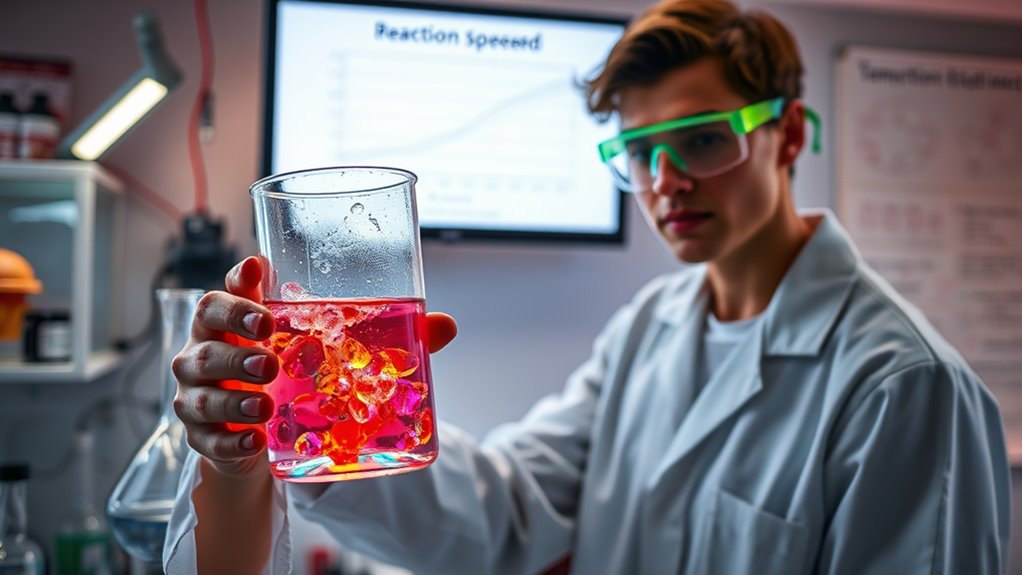
Your reaction speed can change markedly based on concentration and temperature. Increasing the concentration of reactants usually speeds things up, while raising the temperature provides more energy for reactions to occur faster. Understanding these factors helps you control and optimize reaction rates effectively. Additionally, catalysts can accelerate chemical reactions without being consumed in the process. The reaction mechanism also plays a critical role in determining how quickly a reaction proceeds. Moreover, the presence of reaction intermediates can influence the overall rate by either speeding up or slowing down the process.
Concentration Effects
Have you ever wondered how changing the concentration of reactants speeds up or slows down a chemical reaction? The answer lies in how concentration impacts the reaction mechanism and catalyst effects. Increasing reactant concentration typically raises the likelihood of particle collisions, boosting reaction rates. Specifically:
- Higher concentration means more particles in a given volume, increasing collision frequency.
- This leads to a faster formation of the activated complex.
- Catalyst effects become more pronounced with increased reactant availability.
- Reaction mechanisms may shift, favoring faster pathways at higher concentrations.
- The reactant distribution within the reaction mixture can also influence how effectively particles collide and react.
Keep in mind, however, that beyond a certain point, rate increases may plateau. Adjusting concentration is a powerful way to control reaction speed, provided you understand its influence on the underlying mechanisms.
Temperature Impact
Ever wondered how temperature influences the speed of a chemical reaction? This is due to the temperature dependence of reaction rates. As temperature increases, particles move faster, increasing the chances of successful collisions. This often results in a faster reaction. The concept of activation energy helps explain this: higher temperatures provide particles with enough energy to overcome the energy barrier needed for the reaction to proceed. When activation energy is low, reactions tend to be less sensitive to temperature changes, but with higher activation energies, even small temperature increases can markedly accelerate the reaction. Additionally, Hyundai Tuning techniques demonstrate how modifying conditions can optimize performance, similar to how controlling temperature can optimize reaction speed. Understanding how temperature impacts reaction speed helps you predict and control chemical processes more effectively. So, adjusting temperature is a powerful way to influence reaction rates based on their activation energy, especially when considering reaction mechanisms and their sensitivity to temperature variations. Moreover, recognizing the temperature dependence of reaction rates allows chemists to design experiments and industrial processes more efficiently.
How to Measure Reaction Rates
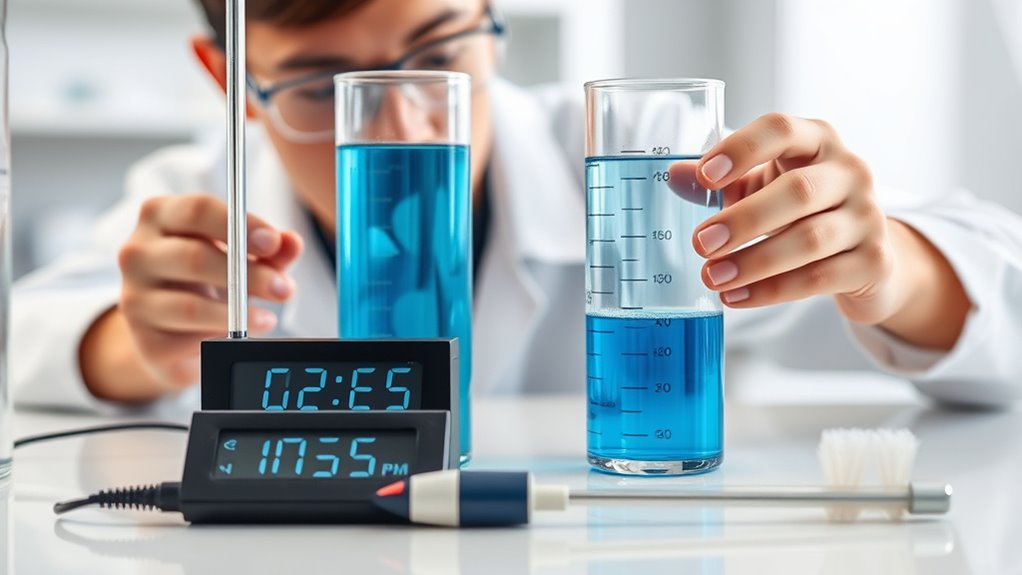
How exactly can you determine how quickly a chemical reaction occurs? You measure reaction rates by monitoring changes in reactant or product concentrations over time. Here are key methods to contemplate:
- Use spectrophotometry to track absorbance changes, revealing reaction progress.
- Measure gas volume or pressure if gases are involved.
- Track pH shifts when reactions involve acidity or alkalinity.
- Observe catalyst effects on reaction speed, which influence reaction mechanisms and overall rate.
- Be aware of AI safety measures that can be integrated into automated monitoring systems to ensure accurate data collection and safety.
- Understanding the reaction mechanism can provide deeper insights into factors affecting the rate of reaction.
- Implementing data analysis techniques can help interpret complex reaction data and identify kinetic parameters more effectively.
The Role of Concentration and Temperature
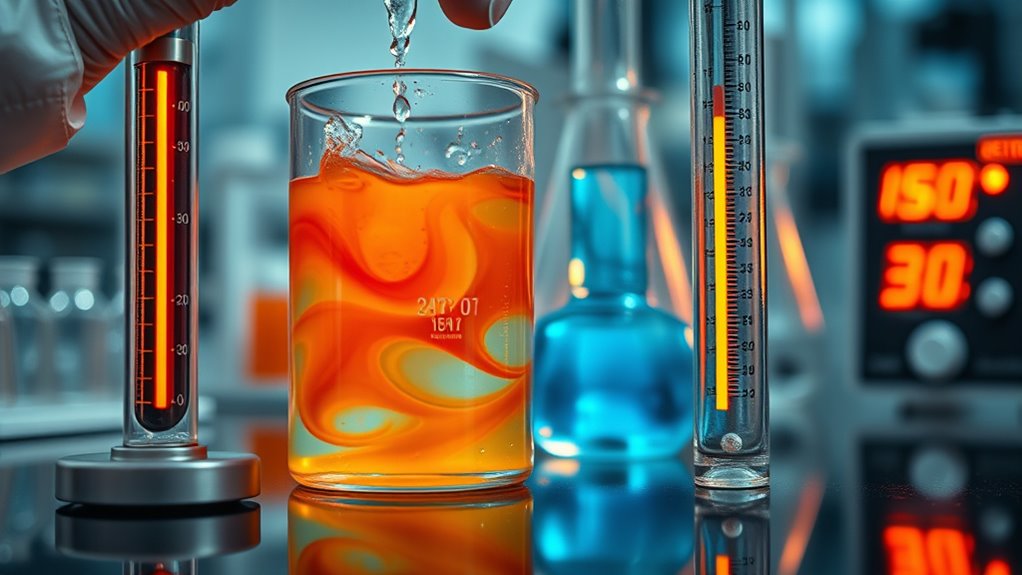
Concentration and temperature are two of the most influential factors affecting reaction rates. Higher concentrations increase the likelihood of reactant collisions, speeding up reaction mechanisms. Similarly, raising the temperature provides react molecules with more energy, leading to more effective collisions and faster reactions. Temperature changes can also influence catalyst effects, as catalysts often work by providing alternative pathways with lower activation energies. These factors alter the rate at which reactions proceed and can change the pathway or mechanism involved. Understanding how concentration and temperature impact the kinetics helps you control reaction speeds in practical applications. Adjusting these parameters allows you to optimize processes, improve efficiency, and better predict how different conditions will influence the overall reaction rate. The history of pinball machines offers insight into how entertainment technology has evolved, paralleling the way scientific understanding advances through experimentation and innovation. Moreover, controlling these factors is essential for reaction optimization in industrial and laboratory settings.
Basic Rate Laws and Equations
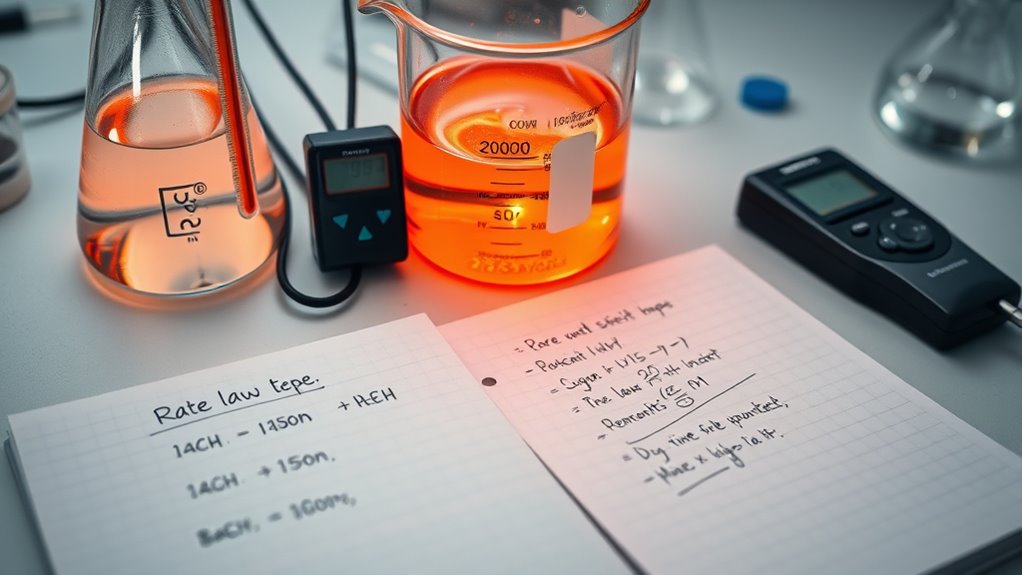
Understanding the basic rate laws and equations is essential for predicting how reaction rates depend on reactant concentrations. These laws help you quantify how factors like catalysts effects influence the speed of reactions. Typically, rate laws are expressed as:
- The rate law’s form, showing dependence on reactant concentrations.
- The order of reaction, indicating how concentration affects rate.
- The rate constant, a specific value for each reaction.
- The influence of catalysts in lowering activation energy, altering the reaction mechanism.
Real-Life Applications of Chemical Kinetics
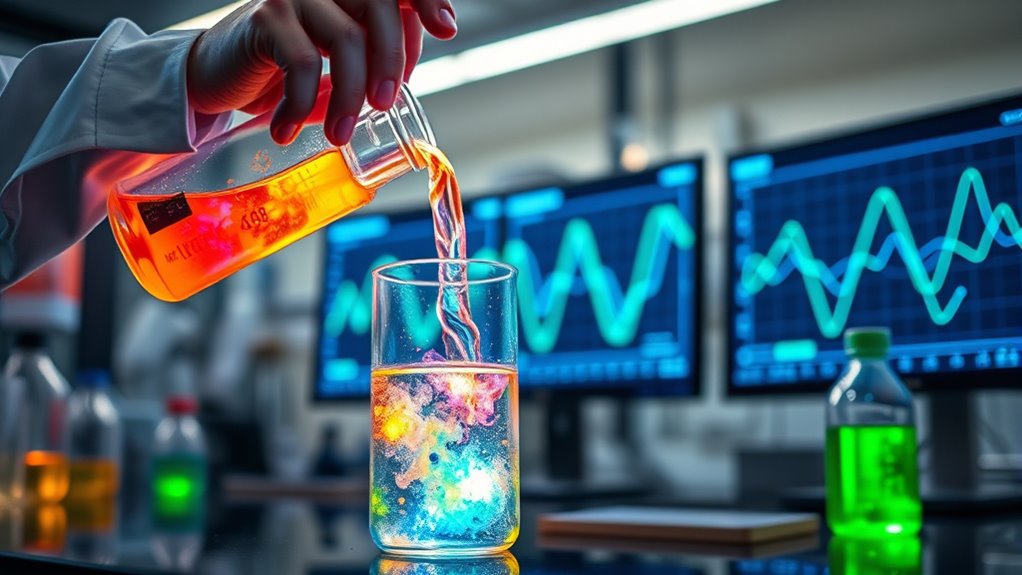
Chemical kinetics play a crucial role in many real-world applications, from optimizing industrial processes to developing effective medical treatments. In chemical manufacturing, understanding reaction rates helps you control product quality and maximize efficiency. By analyzing reaction kinetics, you can fine-tune conditions to minimize waste and energy use. Environmental modeling relies heavily on chemical kinetics to predict how pollutants disperse and degrade over time, aiding in pollution control and ecosystem protection. You can simulate the speed of chemical reactions in the environment, leading to better policies and remediation strategies. These applications demonstrate how grasping reaction rates isn’t just theoretical; it directly impacts industries and the health of our planet. By applying kinetic principles, you contribute to advancements that improve quality of life and environmental sustainability.
Frequently Asked Questions
How Can Chemical Kinetics Be Applied in Environmental Science?
You can apply chemical kinetics in environmental science by understanding pollutant degradation rates, helping you develop effective cleanup methods. It also plays a key role in climate modeling, as reaction rates influence greenhouse gas behavior in the atmosphere. By studying how quickly pollutants break down and how atmospheric reactions proceed, you gain insights into pollution control strategies and climate change predictions, making your efforts more targeted and impactful.
What Are the Common Misconceptions About Reaction Rates?
You might believe reaction rate myths, like faster reactions always being more dangerous or that catalysts change equilibrium, but these are common kinetics misconceptions. In reality, reaction rates depend on factors like concentration and temperature, not just speed. Catalysts speed up reactions without affecting equilibrium. Understanding these facts helps you avoid misconceptions and better grasp how reactions truly work, ensuring you’re not misled by common kinetics myths.
How Does Catalysis Alter Reaction Speed Fundamentally?
Imagine speeding up a race by creating a shortcut—that’s what catalysts do. They alter the catalyst mechanism, providing an alternative reaction pathway with a lower activation energy. This change doesn’t affect the overall reaction but accelerates it markedly. By reducing the energy barrier, catalysts enable reactions to proceed faster without being consumed, fundamentally changing reaction speed and efficiency in chemical processes.
Are There Any Safety Concerns When Studying Reaction Kinetics?
When studying reaction kinetics, you should prioritize laboratory safety and always wear personal protective equipment like gloves, goggles, and lab coats. Handling chemicals and equipment can pose risks such as spills, burns, or inhalation of harmful fumes. Following safety protocols minimizes these dangers, ensuring you stay safe while exploring reaction rates. Always be cautious, attentive, and prepared to prevent accidents and protect yourself during kinetic experiments.
How Does Chemical Kinetics Relate to Industrial Manufacturing Processes?
Think of industrial manufacturing as a well-orchestrated symphony, where reaction mechanisms and rate laws are your guiding notes. Chemical kinetics helps you understand how quickly reactions occur and how different factors influence them. By analyzing these, you can optimize processes, control product quality, and reduce costs. This knowledge allows you to fine-tune reaction conditions, ensuring efficient production and consistent results in industries like pharmaceuticals, plastics, and fuels.
Conclusion
Now that you’ve explored the fundamentals of chemical kinetics, you’re like a detective unraveling the mystery behind reaction speeds. Remember, understanding how factors like concentration and temperature influence reactions empowers you to predict and control chemical processes. With this knowledge, you hold the key to unlatching faster, more efficient reactions—like steering a ship through choppy waters with confidence. Keep practicing, and soon, these concepts will become second nature in your chemistry journey.
